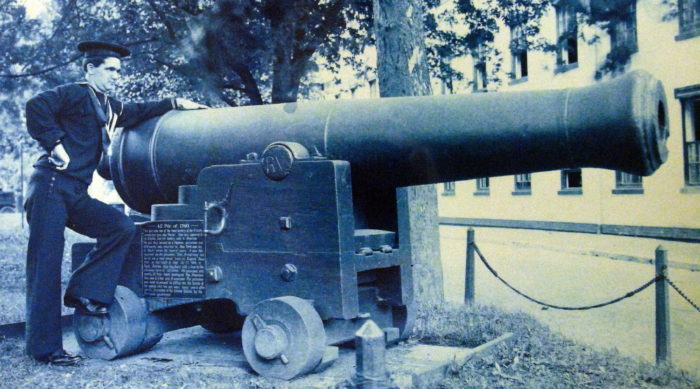
Over the last couple of weeks, we have looked at Mary Logan’s idiosyncratic look at Washington D.C. during here long stay here in the late 19th century, including the Navy Yard. Her last stop there is the collection of historic guns near the Commandants house:
Here for example is a queer specimen known as “Long Tom,” a 42-pounder cast in France in 1786 and captured from the French frigate Noche by the British in 1798, and later sold to the United States. Placed on one of our frigates it was struck by a shot and condemned, but was sold to Haiti, then at war with France. Afterwards it had various owners, and in 1814 formed the main reliance of the privateer General Armstrong, which, by pluckily fighting three British war ships in the Azores, so crippled them that they were unable to reach New Orleans in time to help the land forces against Jackson.
Long Tom did indeed have a checkered history. Cast as a “full cannon,” which could fire 42 pound metal balls, it was of a style that would be discontinued as unwieldy by the beginning of the following century. Its main claim to fame during its brief time aboard the General Armstrong.
Built as a privateer early in the war of 1812, The General Armstrong spent two years attacking British shipping in the Atlantic, earning the owners of the ship a handsome return on their investment. Its most famous engagement came in late September, 1814, three months before the Treaty of Ghent ended the war. The General Armstrong was in the Portuguese port of Fayal, in the Azores, when it was attacked by British marines from three warships that had arrived there. While the General Armstrong was able to repulse several attacks, it became clear that one of them would succeed before too long – and thus Captain Samuel Reid (pictured) ordered that his ship be scuttled by the simple expedient of firing Long Tom straight down through the hull. While the ship did not sink fast enough to keep the British from boarding it, all American sailors escaped safely to shore, where they were protected by Portuguese authorities.

Subsequently, the story grew up that the British were delayed in their mission to attack New Orleans, and it was due to this delay that they lost that battle to Andrew Jackson. Chiefly responsible for spreading this tale was none other than Theodore Roosevelt, who wrote an account of the War of 1812 in 1882. However, a look at the British records of the time shows that, rather than being delayed, the three ships that scuffled with the General Armstrong actually arrived at their next destination ahead of schedule.
Long Tom was pulled out of the waters of Fayal shortly after the battle, and for the next almost 80 years graced a fort om the Azores. When the King of Portugal was looking for ways of marking the imepending world’s fair, he offered to return cannon to the United States. It was loaded aboard a US man-of-war and brought to Chicago, where it was displayed in Jackson Park.
Thereafter, it was turned over to the Navy and displayed, first, as Mrs. Logan describes, outside the commandants house, then in the Naval Museum on the grounds of the Navy Yard.
